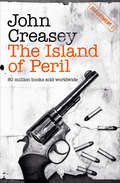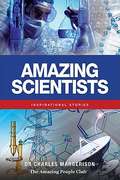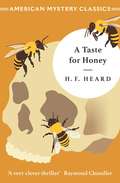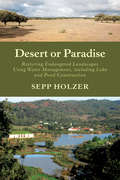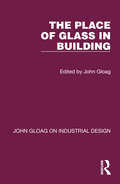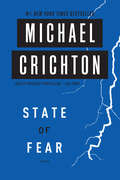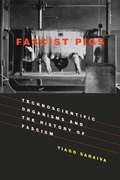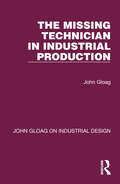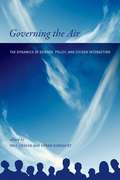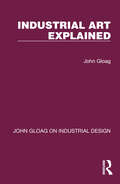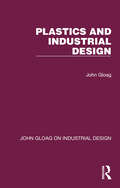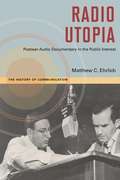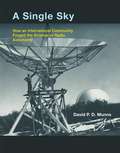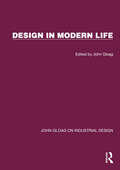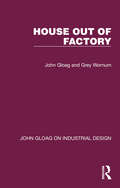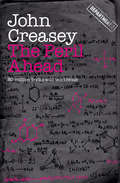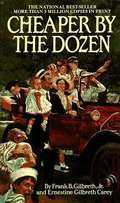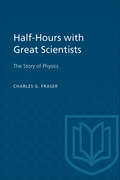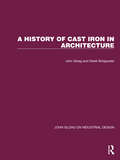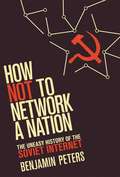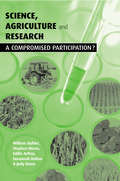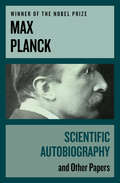- Table View
- List View
The Island of Peril (Department Z #15)
by John CreaseyDepartment Z must stop the Nazis from deploying a deadly chemical weapon during World War II—from the author who sold eighty million books worldwide. On a top-secret island, the Germans are perfecting a paralyzing gas—one that could disable an entire infantry troop, a crew of a ship, or the pilots of aircraft. With the looming threat of this noxious gas, it’s up to Department Z to find this mysterious island where the gas is being manufactured and steal the formula to prevent the Germans from using it as their ultimate weapon. “Mr. Creasey realizes that it is the principal business of thrillers to thrill.” —Church Times “Little appears in the newspapers about the Secret Service, but that little makes anything on the subject probable fiction. Mr. Creasey proves himself worthy of the chance.” —The Times Literary Supplement
Amazing Scientists
by Charles MargerisonWhat would Charles Darwin say if he was interviewed about his life and work? How would Galileo reflect upon his contribution to scientific discovery? In their day, there were few newspapers or journalists to tell these stories, however in Amazing Scientists, the stories of amazing people including Isaac Newton, Linus Pauling, and Louis Pasteur come alive. The bounds of possibility in the many fields of science, including chemistry, physics, psychology, engineering and medicine, are always being stretched. This book helps us understand the ways in which this can happen, through the life stories of people who have made such achievements.This unique collection of short life stories reveals the lives some of the world's greatest and most influential scientists. Meet Einstein, Curie, Faraday, Newton, Tesla and Salk, and get a very personal sense of what they achieved in their lives. Understand the challenges and risks they all faced. Explore the social as well as the technical aspects of their lives. Be inspired as their stories come alive through BioViews® which offer new perspective on the lives of these amazing people.What is a BioView®? A BioView® is a short biographical story, similar to an interview, about an amazing person. The stories can be read in around ten minutes. They provide an easy way of learning about people who made major contributions to our world. The unique format and flow enables each person's story to come alive, as if it is being personally told to you and reflects their interests, emotions and passions. These are unique life stories that can provide you with inspiration in your own life.Visit www.amazingpeopleclub.com to explore this exciting range of books and audio resources.
A Taste For Honey
by H F HeardMycroft has turned detective...A masterclass of classic crime - 'A triumph of ingenuity and horrific simplicity' Boris Karloff'A very clever thriller' Raymond ChandlerIn an English country village, a recluse and a beekeeper team up to catch a cunning villain.Far from the noise of Victorian London, Sydney Silchester's two passions are privacy and honey. But when his honey supplier is found stung to death by her hive, the search for a new beekeeper takes Sydney to Mr. Mycroft, a brilliant man who has retired to Sussex to take up precisely this occupation, and who shares many traits with the great detective, Sherlock Holmes. Mycroft, himself no stranger to crime-solving, immediately senses the bloody hand of murder. But what villain would have the mad intelligence to train an army of killer bees? And will Mycroft risk his own life to find the killer?
Desert or Paradise
by Sepp HolzerSepp Holzer farms steep mountainsides in Austria 5,000 feet above sea level. His farm is an intricate network of terraces, raised beds, ponds, and waterways, well covered with productive fruit trees and other vegetation, in dramatic contrast to his neighbors' spruce monocultures. Fans of Sepp Holzer have come from all over the world to see the productivity of his farm, a veritable permaculture paradise. His first book,Sepp Holzer's Permaculture, offers a detailed guide to what Holzer has achieved on his farm. Many readers might have wondered-but how can we achieve this on a global scale? Luckily, his newest book,Desert or Paradise, examines Holzer's core philosophy for increasing food production, earth health, and reconnecting mankind with nature, applied to reforestation and water conservation across the world. Through years of consultation with other countries, Holzer has developed a core philosophy for reconnecting mankind with nature even in arid or otherwise "lost-cause" regions. He details a process he calls "Grundierung," a term from painting meaning "base coat," which goes into great detail the importance of water, andDesert or Paradiseoffers his concept and guide to construction of large water reservoirs in arid, rainfall-dependent regions with examples from Greece, Turkey, Spain, and Portugal. Holzer describes the ecological and economic benefits of these changes, as well as the use of a variety of plant and animal species for further integration and regeneration of the surrounding areas, including reasons for reforestation and the cause and use of forest fires. Holzer also outlines his ten points of sustainable self-reliance and how these methods can help feed the world, such as the need to regulate the water budget, eliminate factory livestock farming, bring more fallow or unused areas into production, enlarge crop areas by using terracing and Holzer-style raised beds, regionalize instead of globalize, fight for land reform and engage in community building, go back to the ancient farming wisdom, and change the educational system. Also included are Holzer's ideas on beekeeping, humane slaughtering, nature spirits, the loss of roots in our society in general, and in politics especially.
The Place of Glass in Building (John Gloag On Industrial Design Ser.)
by John GloagOriginally published in 1943, The Place of Glass in Building is a comprehensive and compact survey of the structural uses of glass in 20th Century architecture. It gives the facts about the physical properties, the possibilities and the limitations of the glass in common use. It also deals with the attributes of specialised and decorative glass and provides detailed descriptions of the principal types which were manufactured in the UK. Intended for architectural students it may also be of interest to architects, for it is a condensed survey of the progress that has been made in this structural and decorative material.
State of Fear
by Michael CrichtonIn Paris, a physicist dies after performing a laboratory experiment for a beautiful visitor. In the jungles of Malaysia, a mysterious buyer purchases deadly cavitation technology, built to his specifications. <P><P>In Vancouver, a small research submarine is leased for use in the waters off New Guinea.And in Tokyo, an intelligence agent tries to understand what it all means. <P><P>Thus begins Michael Crichton's exciting and provocative technothriller, State of Fear. Only Michael Crichton's unique ability to blend science fact and pulse-pounding fiction could bring such disparate elements to a heart-stopping conclusion. This is Michael Crichton's most wide-ranging thriller. <P><P>State of Fear takes the reader from the glaciers of Iceland to the volcanoes of Antarctica, from the Arizona desert to the deadly jungles of the Solomon Islands, from the streets of Paris to the beaches of Los Angeles. The novel races forward, taking the reader on a rollercoaster thrill ride, all the while keeping the brain in high gear. Gripping and thought-provoking, State of Fear is Michael Crichton at his very best.
Fascist Pigs: Technoscientific Organisms and the History of Fascism
by Tiago SaraivaIn the fascist regimes of Mussolini's Italy, Salazar's Portugal, and Hitler's Germany, the first mass mobilizations involved wheat engineered to take advantage of chemical fertilizers, potatoes resistant to late blight, and pigs that thrived on national produce. Food independence was an early goal of fascism; indeed, as Tiago Saraiva writes in Fascist Pigs, fascists were obsessed with projects to feed the national body from the national soil. Saraiva shows how such technoscientific organisms as specially bred wheat and pigs became important elements in the institutionalization and expansion of fascist regimes. The pigs, the potatoes, and the wheat embodied fascism. In Nazi Germany, only plants and animals conforming to the new national standards would be allowed to reproduce. Pigs that didn't efficiently convert German-grown potatoes into pork and lard were eliminated.Saraiva describes national campaigns that intertwined the work of geneticists with new state bureaucracies; discusses fascist empires, considering forced labor on coffee, rubber, and cotton in Ethiopia, Mozambique, and Eastern Europe; and explores fascist genocides, following Karakul sheep from a laboratory in Germany to Eastern Europe, Libya, Ethiopia, and Angola.Saraiva's highly original account -- the first systematic study of the relation between science and fascism -- argues that the "back to the land" aspect of fascism should be understood as a modernist experiment involving geneticists and their organisms, mass propaganda, overgrown bureaucracy, and violent colonialism.
The Missing Technician in Industrial Production (John Gloag On Industrial Design Ser.)
by John GloagOriginally published in 1944, The Missing Technician shows how Industrial Design must begin at the very first stages of planning a product. The procedure of a design research committee is outlined – a type of practical co-ordination of the work of industrial designers and production technicians which proved highly effective. The value of materials like aluminium and plastic are emphasized, but equally the importance of glass and cast iron is stressed, especially when handled in new ways that 20th Century techniques made possible.
The Egg and I
by Betty MacdonaldThis is the first book, which Betty MacDonald wrote. It chronicles her real-life adventures with her first husband--a man who built a good barn long before fixing the rundown house. Other books by Betty MacDonald are available from Bookshare.
Governing the Air
by Rolf Lidskog Goran SundqvistGoverning the Air looks at the regulation of air pollution not as a static procedure of enactment and agreement but as a dynamic process that reflects the shifting interrelationships of science, policy, and citizens. Taking transboundary air pollution in Europe as its empirical focus, the book not only assesses the particular regulation strategies that have evolved to govern European air, but also offers theoretical insights into dynamics of social order, political negotiation, and scientific practices. These dynamics are of pivotal concern today, in light of emerging international governance problems related to climate change. The contributors, all prominent social scientists specializing in international environmental governance, review earlier findings, analyze the current situation, and discuss future directions for both empirical and theoretical work. [cut last sentence in first para for catalog] The chapters discuss the institutional dimensions of international efforts to combat air pollution, examining the effectiveness of CLRTAP (Convention for Long-Range Transboundary Air Pollution) and the political complexity of the European Union; offer a broad overview and detailed case studies of the roles of science, expertise, and learning; and examine the "missing link" in air pollution policies: citizen involvement. Changing political conditions, evolving scientific knowledge, and the need for citizen engagement offer significant challenges for air pollution policy making. By focusing on process rather than product, learning rather than knowledge, and strategies rather than interests, this book gives a nuanced view of how air pollution is made governable.
Industrial Art Explained (John Gloag On Industrial Design Ser.)
by John GloagOriginally published in 1934 this book became recognised as one of the principal standard works on industrial design and industrial architecture. The chapters explain the complete operation, character and background history of industrial art, its relation to architecture, materials, industrial production and retail distribution. It is fully illustrated with line drawings and photographs.
Plastics and Industrial Design (John Gloag On Industrial Design Ser.)
by John GloagOriginally published in 1945, Plastics and Industrial Design is a non-technical work of reference for manufacturers and designers who, after the Second World War were beginning to realize the possibilities that manufacturing with Plastics could bring. The different types of plastics and their uses is discussed, as is their impact on the design of manufactured articles. Whilst the extensive use of plastic may have fallen out of favour in recent years due to environmental concerns, this book reminds us that in their infancy they offered exciting manufacturing possibilities.
Radio Utopia: Postwar Audio Documentary in the Public Interest
by Matthew C. EhrlichAs World War II drew to a close and radio news was popularized through overseas broadcasting, journalists and dramatists began to build upon the unprecedented success of war reporting on the radio by creating audio documentaries. Focusing particularly on the work of radio luminaries such as Edward R. Murrow, Fred Friendly, Norman Corwin, and Erik Barnouw, Radio Utopia: Postwar Audio Documentary in the Public Interest traces this crucial phase in American radio history, significant not only for its timing immediately before television, but also because it bridges the gap between the end of the World Wars and the beginning of the Cold War. Matthew C. Ehrlich closely examines the production of audio documentaries disseminated by major American commercial broadcast networks CBS, NBC, and ABC from 1945 to 1951. Audio documentary programs educated Americans about juvenile delinquency, slums, race relations, venereal disease, atomic energy, arms control, and other issues of public interest, but they typically stopped short of calling for radical change. Drawing on rare recordings and scripts, Ehrlich traces a crucial phase in the evolution of news documentary, as docudramas featuring actors were supplanted by reality-based programs that took advantage of new recording technology. Paralleling that shift from drama to realism was a shift in liberal thought from dreams of world peace to uneasy adjustments to a cold war mentality. Influenced by corporate competition and government regulations, radio programming reflected shifts in a range of political thought that included pacifism, liberalism, and McCarthyism. In showing how programming highlighted contradictions within journalism and documentary, Radio Utopia reveals radio's response to the political, economic, and cultural upheaval of the post-war era.
A Single Sky: How an International Community Forged the Science of Radio Astronomy
by David P. D. MunnsFor more than three thousand years, the science of astronomy depended on visible light. In just the last sixty years, radio technology has fundamentally altered how astronomers see the universe. Combining the wartime innovation of radar and the established standards of traditional optical telescopes, the "radio telescope" offered humanity a new vision of the universe. In A Single Sky, the historian David Munns explains how the idea of the radio telescope emerged from a new scientific community uniting the power of radio with the international aspirations of the discipline of astronomy. The radio astronomers challenged Cold War era rivalries by forging a united scientific community looking at a single sky.Munns tells the interconnecting stories of Australian, British, Dutch, and American radio astronomers, all seeking to learn how to see the universe by means of radio. Jointly, this international array of radio astronomers built a new "community" style of science opposing the "glamour" of nuclear physics. A Single Sky describes a communitarian style of science, a culture of interdisciplinary and international integration and cooperation, and counters the notion that recent science has been driven by competition. Collaboration, or what a prominent radio astronomer called "a blending of radio invention and astronomical insight," produced a science as revolutionary as Galileo's first observations with a telescope. Working together, the community of radio astronomers revealed the structure of the galaxy.
Design in Modern Life (John Gloag On Industrial Design Ser.)
by John GloagOriginally published in 1946, this book is based on a series of broadcast talks on design. Led by an engineer, an artist and critic of architecture and industrial design, the discussions focussed on the problems that were involved by a general application of design to the environment of contemporary life. It surveys the possibilities of design in modern life and the talks have been rewritten, amplified and revised for the purposes of the book.
House Out of Factory (John Gloag On Industrial Design Ser.)
by John Gloag Grey WornumOriginally published in 1946, when Britain was facing a post-war housing crisis, this book dealt with the issue of the factory-produced house in being part of the solution for housing people in an affordable manner and a short time-scale. The book, aimed at both lay-people and technicians discusses aspects of pre-fabricated housing such as comfort, standardisation and aesthetics. The book is illustrated with 48pp of black and white plates.
The Peril Ahead (Department Z #22)
by John CreaseyDepartment Z tracks down a doomsday weapon in an edge-of-your-seat spy thriller from the Edgar Award–winning author who sold eighty million books worldwide. Professor Toller has created a weapon that could change the world as we know it. The threat is imminent as the professor and his formula are kidnapped, and it is left to the head of Department Z, Gordon Craigie, to save the day. Department Z is a small and little-known faction of the intelligence service. Among the other branches, its work is legendary. The department’s agents are scattered across most of the world’s capitals and even in smaller cities, and many strange matters pass through their hands. Or, more accurately, the hands of Gordon Craigie and Bill Loftus. Craigie must take enormous risks as both Washington and Moscow begin to suspect Britain of seeking out such a destructive weapon. His investigation leads him to an English seaside resort where Craigie must track down the men that have taken the professor, while evading the master conspirator who is out to get him. When the conspirator goes after the prime minister, Craigie is in real trouble. “Mr. Creasey realizes that it is the principal business of thrillers to thrill.” —Church Times “Little appears in the newspapers about the Secret Service, but that little makes anything on the subject probable fiction. Mr. Creasey proves himself worthy of the chance.” —Times Literary Supplement
Men Against Fire: The Problem of Battle Command in Future War
by S. L. A. MarshallThis book examines why only one in four men in battle seem to fire their guns, and offers means by which the number of active soldiers can be increased.
Cheaper by the Dozen
by Frank B. Gilbreth Ernestine Gilbreth CareyThis is the true story of the Gilbreth family. It is often humorous, sometimes tender, always poignant. Frank and Lillian Gilbreth changed the way many jobs were done. They balanced professional careers with raising twelve children--six boys and six girls--long before it was the norm. This edition contains the entire text of the original edition, and teens and adults will find this book to be delightful and entertaining.
Half-Hours with Great Scientists: The Story of Physics
by Charles G. FraserThe present age is sometimes called the Scientific Age. This does not imply that every member of the community is an expert scientist—far from it. It does mean, however, that the labours of the scientists have given the age certain features which influence the life of every citizen to some degree. Accordingly it is desirable that as many as possible should have some understanding of the scientists' work, of their aims, their point of view, and their methods. If we had a wishing-rug or some sort of spare-time car that could transport us at will to any place and time, we might visit the scientists of every age, see them at work, listen to their discussions, and even take a hand in the proceedings. The wishing-rug is not available but the literature of science will serve the purpose for anyone who will do the necessary searching, reading, and thinking. Unfortunately, some of that literature is decidedly inaccessible. To meet the difficulty this book has been written in the hope of bringing some of the most important passages of the literature of science within the reach of everyone. Every past of the vast edifice of science is necessarily the work of some human being, and most of us become more interested in the building, and are able to understand and appreciate it better when we know who were the architects and builders and when, how, and why they did their work. The story of science is a noble epic of the struggle of man from ignorance toward knowledge and wisdom and toward the mastery of nature and of himself. One purpose of science is to systematize experience, and a knowledge of the story of science has helped many in that process of organization. This book, therefore, offers the reader a cordial invitation to embark on a tour of visits with great scientists to learn from them the parts they played in the advancement of science and of the human race. Here is a treasure-house of fascinating information for all who are interested in the world around us, and the history of man's understanding of it.
A History of Cast Iron in Architecture (John Gloag On Industrial Design Ser.)
by John Gloag Derek BridgwaterOriginally published in 1948, A History of Cast Iron in Architecture is a comprehensive history of the part that has been played by cast iron in architecture and the allied arts in Britain. Any history of the rise and development of the iron-founding industry becomes virtually a history of the First Industrial Revolution. Examining the use of cast iron by builders and architects from late medieval times to the middle of the 20th Century the authors have also recorded a miniature history of British Industry. The introduction throws light on the early developments of iron-founding. The main sections of the book describe the rise and expansion of the cast-iron industry and its gradually increasing significance in architecture from 1650 to 1945. There are over 500 illustrations.
How Not to Network a Nation: The Uneasy History of the Soviet Internet
by Benjamin PetersBetween 1959 and 1989, Soviet scientists and officials made numerous attempts to network their nation -- to construct a nationwide computer network. None of these attempts succeeded, and the enterprise had been abandoned by the time the Soviet Union fell apart. Meanwhile, ARPANET, the American precursor to the Internet, went online in 1969. Why did the Soviet network, with top-level scientists and patriotic incentives, fail while the American network succeeded? In How Not to Network a Nation, Benjamin Peters reverses the usual cold war dualities and argues that the American ARPANET took shape thanks to well-managed state subsidies and collaborative research environments and the Soviet network projects stumbled because of unregulated competition among self-interested institutions, bureaucrats, and others. The capitalists behaved like socialists while the socialists behaved like capitalists. After examining the midcentury rise of cybernetics, the science of self-governing systems, and the emergence in the Soviet Union of economic cybernetics, Peters complicates this uneasy role reversal while chronicling the various Soviet attempts to build a "unified information network." Drawing on previously unknown archival and historical materials, he focuses on the final, and most ambitious of these projects, the All-State Automated System of Management (OGAS), and its principal promoter, Viktor M. Glushkov. Peters describes the rise and fall of OGAS -- its theoretical and practical reach, its vision of a national economy managed by network, the bureaucratic obstacles it encountered, and the institutional stalemate that killed it. Finally, he considers the implications of the Soviet experience for today's networked world.
Science Agriculture and Research: A Compromised Participation
by Stephen Morse Susannah Bolton Eddie Arthur William Buhler Judy MannResearch is never free of pressures and constraints and to understand its results properly these have to be assessed and analyzed. In agriculture, research into biotechnology and GMOs, as well as pesticides and herbicides, is big business - agribusiness. This book looks at the crucial roles of funding and the political context on the research agenda and its results in agricultural development. It provides a critical evaluation of the participatory methods now widely used and explores the ways in which research into biotechnology have reflected the interests of the various parties involved.
Scientific Autobiography: And Other Papers
by Max PlanckIn this fascinating autobiography from one of the foremost geniuses of twentieth-century physics, Max Planck tells the story of his life, his aims, and his thinking. Published posthumously, the papers in this volume were written for the general reader and make accessible Planck&’s scientific theories as well as his philosophical ideals, including his thoughts on ethics and morals.
Scientific Autobiography: And Other Papers
by Max PlanckIn this fascinating autobiography from one of the foremost geniuses of twentieth-century physics, Max Planck tells the story of his life, his aims, and his thinking. Published posthumously, the papers in this volume were written for the general reader and make accessible Planck&’s scientific theories as well as his philosophical ideals, including his thoughts on ethics and morals.
